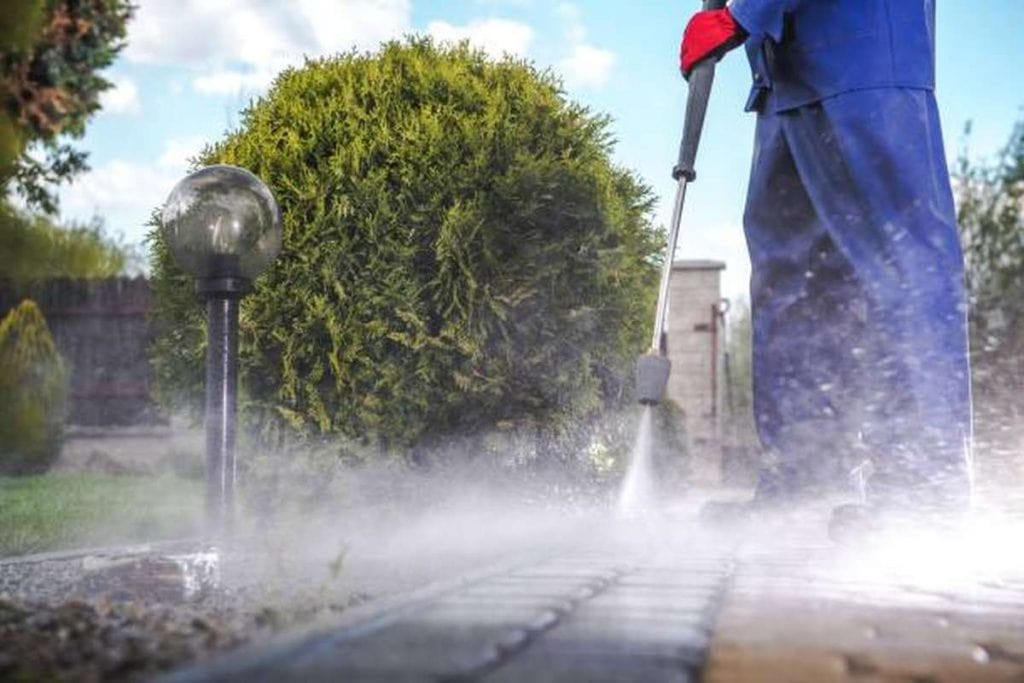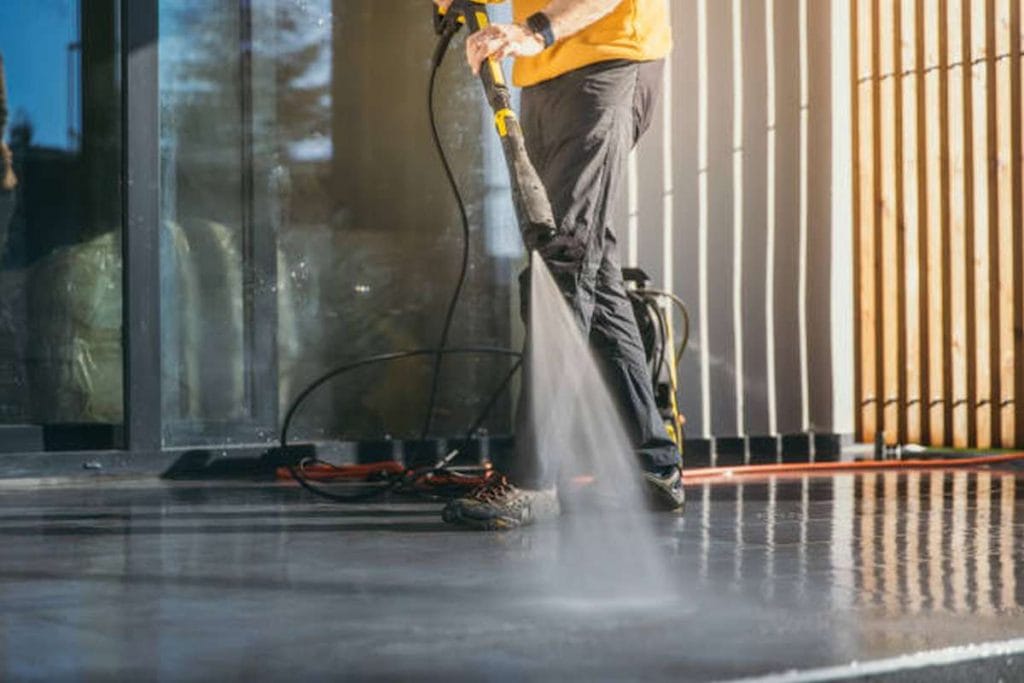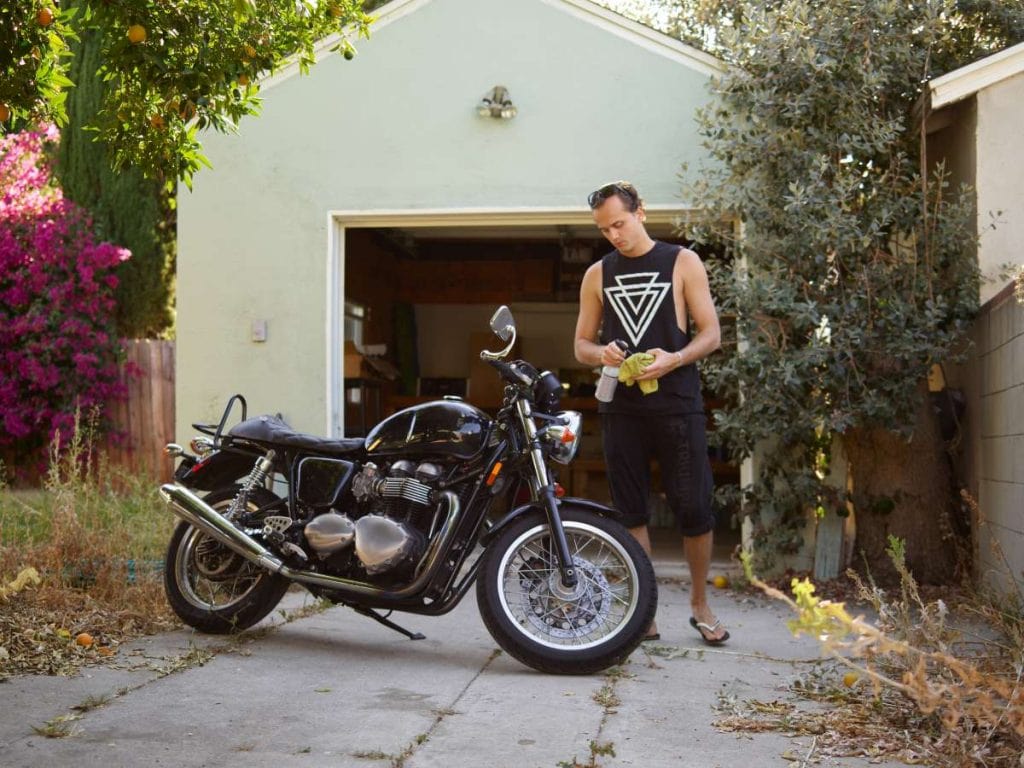Intent on restoring your driveway to its original splendour? Are you sick of the sight of the mildew and oil stains that have accumulated on top of the dirt? Yes, this is the solution you've been looking for!
This article will discuss the best ways to clean a driveway, quickly, easily, and safely–from selecting the appropriate cleaning product and tools to tackling the roughest, dirtiest jobs (from the pros, no less). In such a case, read for some excellent guidance on restoring your driveways to their former glory.
How to Clean Your Driveway: Complete Guide
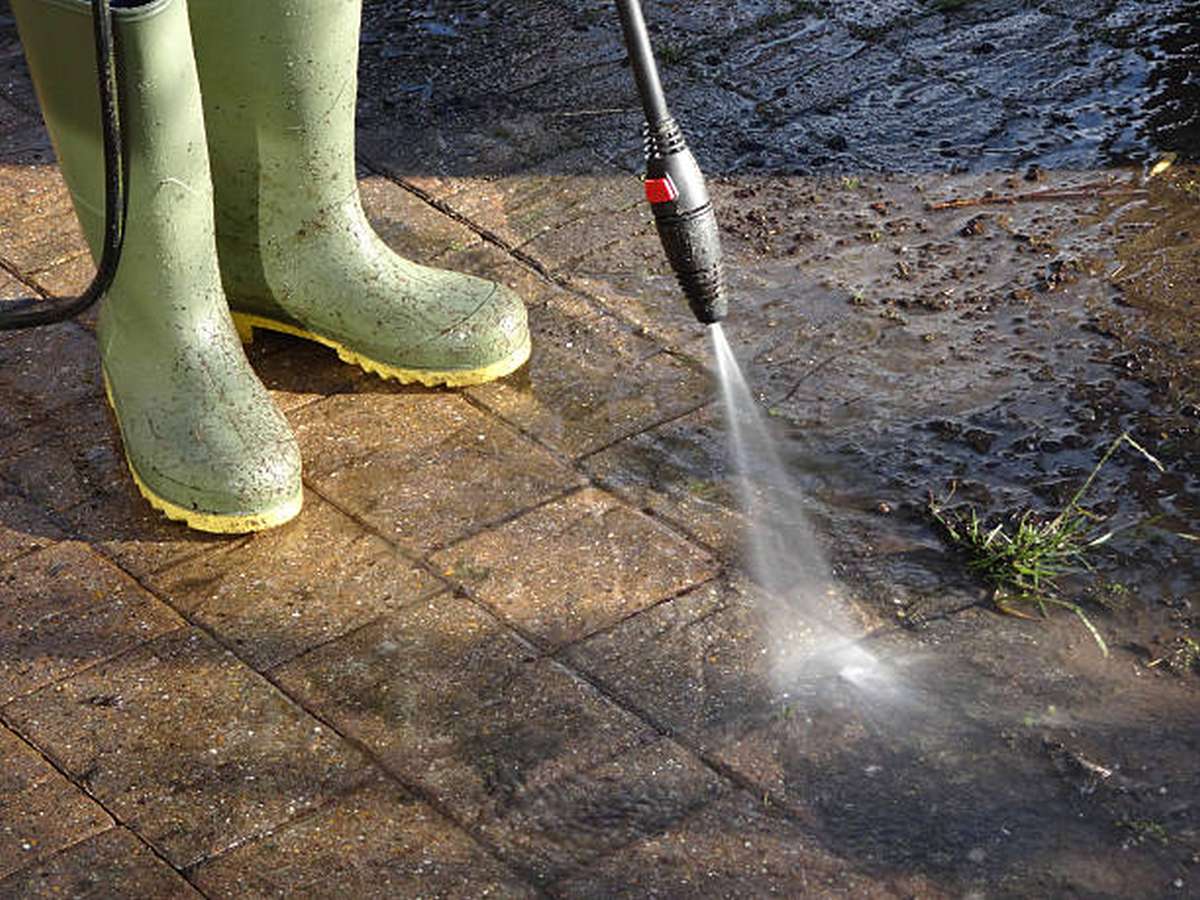
Stains from paint, varnish, oil, or even permanent marker from youngsters playing hopscotch are all common occurrences on a frequently used driveway, especially one owned by a do-it-yourselfer. Melbourne's Pressure Washing is the most trusted and reliable pressure washing company in all of Melbourne!
Some messes can be cleaned by sweeping or hosing them down, while others need special stain-remover products. It depends on the driveway material (concrete or asphalt) and the stain to be removed as to which method is most effective.
Identify the Concrete Driveway Cleaning Tools Available
We suggest gathering the following materials before getting started:
- Dustpan
- Broomstick
- Bucket\s
- Gloves
- Glass container for spraying
- Water hose and scrub brush
- Pressure washer for cleaning concrete driveway
Different cleaning products will be required depending on the nature of the stains and grime. For instance, if you have dirt that just won't budge, a pressure washer will do the trick. In any case, you ought to be competent in your endeavour. Although concrete is a hard substance, it is important to note that pressure blasting the surface at a higher level than necessary might cause damage to the material. Power washers have a spray range of 1,500-3,300 psi, which is 50 times stronger than a standard garden hose. Surface etchings can be caused by a high setting or blasting too near the surface.
You May Go for the Bare Essentials: Water and Soap.
Concrete driveway cleaning doesn't have to be elaborate. Cleaning with just old-fashioned soap and water works just fine. First, put some dish soap into a big pail of water and use that to clean the dishes. The next step is to get your metal-free, hard scrub brush. Then, using circular motions, begin scrubbing.
As you make your way to the street, you might find it easiest to start at the far end of the driveway. This is the most convenient solution since it eliminates the need to go back and manually direct the water away from the driveway. Instead, use a spray nozzle attached to your garden hose to give the area more rinsing to eliminate any lingering dirt or stains.
Use Pressure Washing
Power washing was briefly discussed earlier. Power washing is a common method demonstrated when teaching people how to clean a concrete driveway. That's because it does a great job of washing out even the most entrenched stains and filth. If you're working on concrete, you should switch to a fan-shaped tip. Even at a lesser level, using hot water will increase the efficiency of your pressure washing.
A power washer is a powerful cleaning tool. However, only someone with experience using one should try to. If you're washing something, you should switch to a new area every 10 seconds. Spraying for too long in one area can cause problems.
Take Advantage of an Industrial Cleaner
How do you remove oil from a concrete driveway? A degreaser like trisodium phosphate (TSP) is the answer to this problem. But, if you can, avoid getting the cleaner on your skin. Thus, it is crucial to use rubber gloves and goggles when working with TSP.
Bleach It Out
Bleach is a proven household product for removing fabric stains, as you probably already know. In addition, chlorine bleach can be used to clean the concrete surface of the driveway. Naturally, it needs to be diluted with water, and the ratio should be 1:1.
It's time to spray the mixture on the driveway and wait 10 minutes. Next, scrub with a bristle brush and flush with clean water. In any cleaning situation using bleach, appropriate safety equipment must be worn.
Tips for Removing Oil and Grease From a Concrete Driveway.
Sometimes all that's needed to get rid of a small oil spill or spot is a scrub brush and a powerful detergent. Concrete cleaners and degreasers, concentrated alkaline soaps, are preferable because they break down the oil and make it simpler to remove. Use absorbent materials like baking soda, sawdust, cat litter, etc., to cover new spills before cleaning them up.
There are other options for removing grease stains without using cat litter. You can also use dry cement, a quick and simple solution. Use it the same way: set it on top of the grease and wait for it to absorb the stain over a few days. Cement should be thrown away in the trash can, not the sink, once finished.
In the event of a gasoline leak, sand is another viable option. Maybe you've filled up your car or lawnmower but forgot to point the spout in the right direction. In this scenario, regular sand can be poured over the leak to contain the mess. For maximum gasoline absorption by the sand, leave it there overnight. The following day, collect the sand you swept off the concrete driveway in a sealed container. Next, use water and dish soap to remove any remaining petrol stains. Finally, use a yard hose to spray water over the area.
Ways to Remove Paint Splatters and Drips From a Driveway
Paint drips from an outdoor furniture installation are unsightly on asphalt and concrete. Scrubbing the spill with water, scouring powder, and a stiff-bristled nylon brush can often remove stains from latex-based paint. Then, use a yard hose to flush the area out.
Spatters of oil and acrylic paint are more difficult to clean up. If your driveway is made of asphalt, you may consider applying an asphalt sealer to rejuvenate the driveway's black surface and hide any paint splatters. However, the oil-based paint remover is too harsh for asphalt and should be reserved for concrete.
Concrete paint removal is the same as refurbishing an old furniture item. You just have to take it off. Apply a paint-stripping solution to the splatters by pouring it on or brushing it on, and then scrub it into the pavement with a firm, natural-bristle brush. Wash it off when the recommended amount of time has passed.
Are you looking for a professional high-pressure steam cleaning to blast away dirt and grime? Pressure Washing Melbourne is the perfect company for the job!
Tips for Getting Rid of Tire Marks
The migration of plasticisers into the sealant at high temperatures makes tyres more likely to leave markings. In addition, it will leave a stain that may be tough to eliminate. When dealing with tyre tracks on the driveway, a degreaser is frequently the quickest and easiest fix. Choose a product that doesn't harm the environment or is manufactured with an acid that won't eat away at the material. Besides removing salt, rust, and lime, this procedure is useful for removing salt deposits and other substances. A coatings remover could clean up any paint, epoxy, or other spills on the concrete driveway.
Whether it's a store-bought item or something you whipped up yourself, you should always read up on the product before utilising it. For example, if you have a concrete driveway, test a tiny area to be sure it won't harm the surface.
Advice for Maintaining Your Concrete Driveway in General
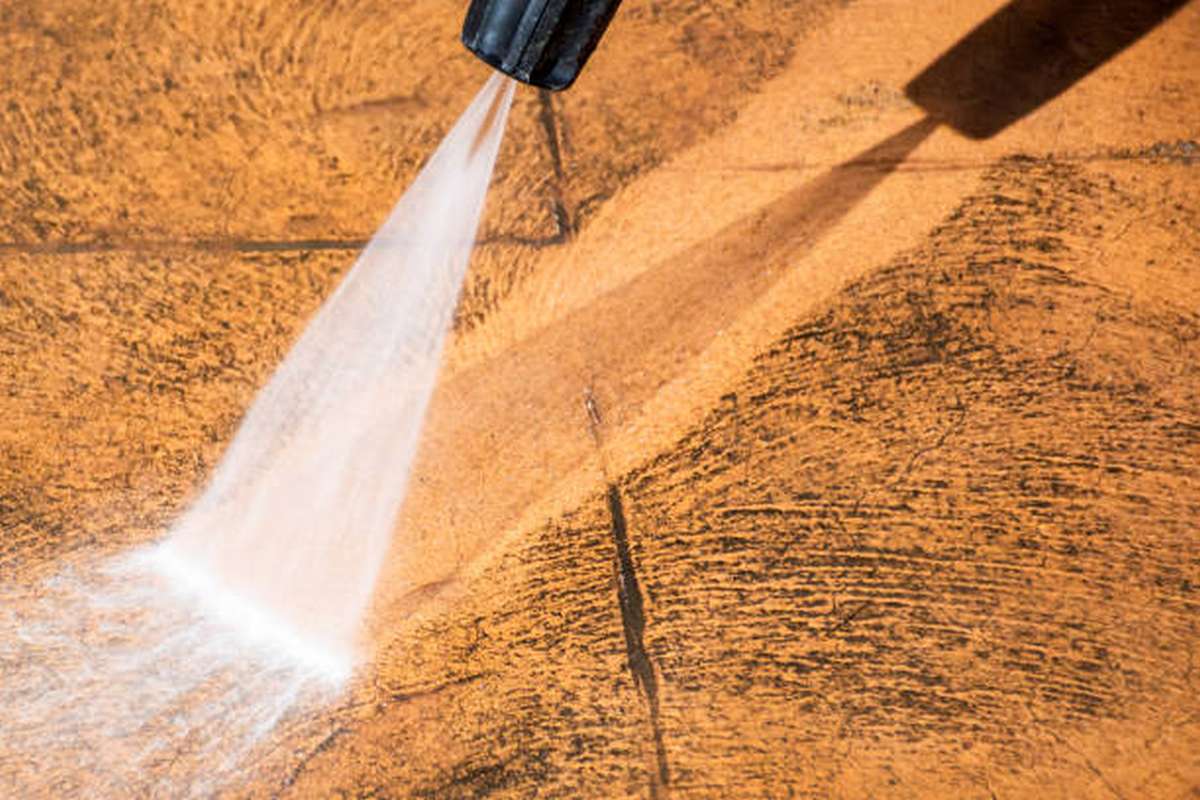
The Sealant Should Be Reapplied as Necessary.
Every few years, you must reseal your driveway to keep it looking new and protect it from spills and stains. However, if you want to avoid trapping moisture in the concrete after cleaning it, wait at least two or three days before sealing it again.
Move Quickly.
It will be easier to get rid of stains left by grease, oil, paint spills, leaves, and other impurities on your concrete driveway if you clean them up as soon as possible. However, unprotected concrete can easily absorb stains because of its porous nature. Therefore, it will be considerably more challenging to get rid of them in the future.
Do Not Use Chemicals to De-ice.
Deicers used on a concrete driveway in the winter can harm the surface by pushing the thawing and refreezing of moisture, resulting in scaling and spalling. Deicing salts and the drip-off of parked cars can also cause sealers for asphalt driveways to fail. Use sand if you need to gain traction instead.
Driveways Made of Concrete Pavers Will Benefit From Re-Sanding.
Driveways made of concrete pavers require the same regular upkeep as those made of poured concrete. Additionally, if the sand between the pavers has been washed away, you may need to replace it. To stop erosion, you must use polymer sand treated with a particular polymeric ingredient.
Final Thoughts
As soon as a stain is noticed, remove it so the driveway can remain clear. The entire house can take on careless, unkempt air if the driveway has more than one kind of stain, including mud and mechanic's grease. Some stains, like paint splatters, can be more difficult to remove the longer they sit.
Our driveway and patio cleaning for Melbourne experts use the latest in concrete and high pressure washing technology to clean your driveway, patio, and pathways. No job is too big or too small for us – we’ll take care of everything for you.
Conclusion
Are you weary of seeing the mildew and oil stains that have built up on top of the dirt? The most effective methods for driveway cleaning are covered here. The type of dirt and grime will dictate which cleaning supplies are necessary. The pressure of a power washer's spray can be anywhere from 1,500 to 3,300 psi, making it 50 times more powerful than the water released from a regular garden hose. Apply a final rinse with a spray nozzle linked to your garden hose to get rid of any trace of dirt or stains that may have been missed during the initial washing.
You likely already know that bleach is an effective home solution for eliminating fabric stains. New spills should be covered with absorbent items like baking soda, sawdust, cat litter, etc. until they can be cleaned up. Oil and paint splatters on asphalt and concrete driveways can be easily removed with sand. Standard sand can be dumped over a leak from a car or lawnmower to limit the spill. Stains from latex paint may usually be scrubbed away with water, scouring powder, and a stiff-bristled nylon brush.
To maintain the driveway's pristine appearance and prevent it from spills and stains, resealing it is necessary every few years. When you clear up grease, oil, paint spills, leaves, and other debris as soon as possible after they land on your concrete driveway, the resulting stains will be easier to remove. Because of its porous nature, unprotected concrete readily absorbs stains.
Content Summary
- The most effective methods for driveway cleaning are covered here.
- From choosing the right cleaning product and tools to completing the toughest, dirtiest jobs, this guide has it all (from the pros, no less).
- If that's the case, keep reading for some top-notch advice on bringing your driveways back to life.
- A DIY homeowner's often travelled driveway is prone to stains from a variety of sources, including paint, varnish, oil, and even permanent marker from kids playing hopscotch.
- While sweeping and hosing down may be sufficient for some problems, more stubborn stains may require more specialised cleaning agents.
- Which approach is best for removing a stain from a driveway depends on the driveway material (concrete or asphalt) and the stain.
- The type of dirt and grime will dictate which cleaning supplies are necessary.
- For stubborn filth, for instance, a pressure washer is the way to go.
- Whatever you're trying to accomplish, you should do it well.
- Pressure blasting the surface at a greater level than necessary may cause damage to the material, despite the fact that concrete is a durable product.
- The pressure of a power washer's spray can be anywhere from 1,500 to 3,300 psi, making it 50 times more powerful than the water released from a regular garden hose.
- When blasting is done at too high of a setting or too close to the surface, etchings might occur.
- Since you won't have to go back and physically divert the water away from the driveway, this is the most time-efficient option.
- If there is still dirt or stains after you've rinsed, put a spray nozzle on your garden hose to give the area a final rinse.
- Power-washing is the method of choice.
- Before, we touched briefly on the topic of power washing.
- When showing people how to clean a concrete driveway, power washing is a typical approach demonstrated.
- Reason being, it thoroughly removes even the most stubborn dirt and grime.
- A fan-shaped tip is more suited for use on concrete.
- Using hot water with your pressure washer will boost its effectiveness even when set on a lower setting.
- Power washers are extremely effective cleaning tools.
- However, only a person well-versed in their use should attempt this.
- Every 10 seconds, you should move on to a new section to wash.
- The spraying could cause damage if left on one spot for too long.
- Trisodium phosphate (TSP) or another degreaser can solve this issue.
- You should keep the cleaner off your skin at all costs.
- That's why it's so important to use protective gear like rubber gloves and goggles when handling TSP.
- You likely already know that bleach is an effective home solution for eliminating fabric stains.
- The driveway's concrete can also be cleaned using chlorine bleach.
- It must be diluted with water, but only at a 1:3 ratio.
- You should now spray the liquid onto the driveway and wait 10 minutes.
- After that, use a bristle brush to scrub, and then rinse with fresh water.
- Cleaning with bleach requires the use of protective gear.
- In other cases, a strong detergent and a scrub brush are all that's needed to get rid of a little oil spill or spot.
- Place it on top of the grease and let it sit for a few days; it will absorb the discoloration.
- After finishing a cement project, it is recommended that the waste be disposed of in the garbage and not the sink.
- Sand is an alternative of using sand to contain a gasoline spill.
- It's possible that you've filled up your car or lawnmower without remembering to adjust the spout.
- The leak can be contained by pouring normal sand over it.
- If you leave the gasoline on the sand overnight, the sand will be able to absorb as much of the fuel as possible.
- You should save the sand from the concrete driveway that you cleaned up the next day in some kind of container.
- The residual gasoline stains can then be washed away with water and dish soap.
- Finally, spray the area down with water from a garden hose.
- Unsightly paint drips from a new set of patio furniture are a turnoff on the pavement.
- Stains from latex paint can often be removed by scrubbing the spill with water, scouring powder, and a stiff-bristled nylon brush.
- To finish, spray the area down with water from a garden hose.
- Oil and acrylic paint splatters are more of a nuisance to clean up than latex.
- The black asphalt surface of your driveway can be revitalised and any paint splatters can be hidden by applying asphalt sealant.
- Although effective, oil-based paint remover is too abrasive for asphalt and should be saved for the latter.
- As with refinishing antique furniture, stripping paint from concrete is a simple process.
- Get rid of it immediately.
- Scrub the paint-stripping solution into the pavement with a firm, natural-bristle brush after applying a paint-stripping solution to the splatters by pouring or brushing it on.
- After the allotted amount of time has gone, wash it off.
- At elevated temperatures, plasticisers can migrate into the sealant, increasing tyre marking potential.
- There will also be a stain that may be difficult to remove.
- Before using any product, whether it was purchased or made by yourself, it is recommended that you learn as much as possible about it.
- Test a small area beforehand to make sure it won't damage the surface, like in the case of a concrete driveway.
- It's important to reapply the sealant as needed.
- To maintain the driveway's pristine appearance and prevent it from spills and stains, resealing it is necessary every few years.
- However, if you don't want to risk trapping moisture in the concrete, wait at least two or three days after cleaning it before sealing it again.
- When you clear up grease, oil, paint spills, leaves, and other debris as soon as possible after they land on your concrete driveway, the resulting stains will be easier to remove.
- However, due to its porous nature, exposed concrete can readily collect stains.
- This makes it much more difficult to eradicate them in the future.
- It is not acceptable to use chemical deicers.
- If you use deicers on your concrete driveway during winter, you may cause damage by speeding up the thawing and refreezing of moisture, which can lead to scaling and spalling.
- The failure of asphalt driveway sealers is also exacerbated by the application of deicing salts and the leakage from parked cars.
- If you need to get traction, sand is the way to go.
- Concrete paver driveways can be improved by resanding the pavers.
- Concrete paver driveways are just as high-maintenance as poured concrete driveways and need to be repaved on a regular basis.
- In addition, you might have to replenish the sand between the pavers if it has been washed away.
- Erosion can be prevented by employing a specific polymeric ingredient-treated polymer sand.
- If you want to keep the driveway clean, you should clean up spills as soon as you see them.
- If the driveway has more than one form of stain, such as mud and mechanic's grease, it can give the entire house a careless, unkempt aspect.
FAQs About Driveway Cleaning
To clean a concrete driveway, you can use a power washer, a commercial concrete cleaner, or a mixture of water and mild dish soap. It's important to be careful when cleaning concrete, as some cleaning methods and products can damage the surface or cause it to become slippery. Always test a small, inconspicuous area before cleaning the entire driveway, and use caution when handling a power washer.
Just sprinkle powdered dishwashing detergent over the entire driveway. Elbow grease: Using a standard deck brush, dip it into the hot washing soda water and scrub the driveway, rewetting the brush as needed. If you use dish detergent, all you need is a bucket of hot water to scrub the detergent into the pavement.
Concrete driveways are prone to dirt, residue, mould or mildew. Yes, you can clean them with bleach. In fact, bleach not only removes many stains, but it also deodorises and kills mould and mildew when used properly.
What chemical will clean concrete? If you have mildew stains, the best chemical to clean concrete is trisodium phosphate. Combine two tablespoons of the chemical with two tablespoons of powdered laundry detergent and one-quart water. Then, apply it to the stained area and scrub using a stiff brush.
White vinegar and a little scrubbing with a brush is a very effective, eco-friendly way to remove rust stains from concrete—even those that are decades old. Pour the white vinegar directly onto the stain, allow the liquid to penetrate the area for 20 minutes, and scrub with a stiff-bristled brush.

